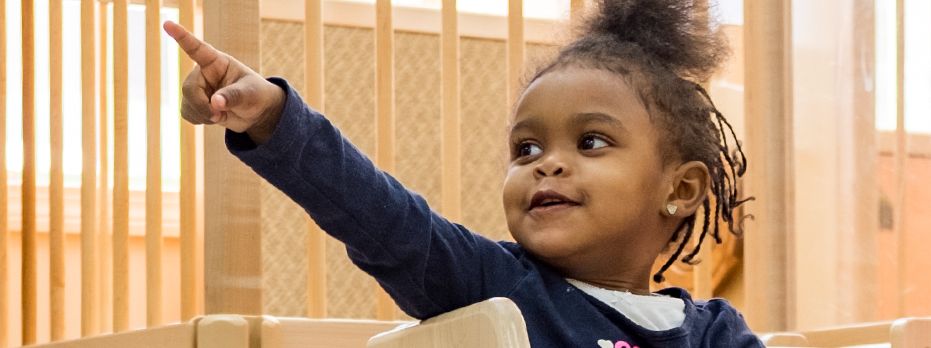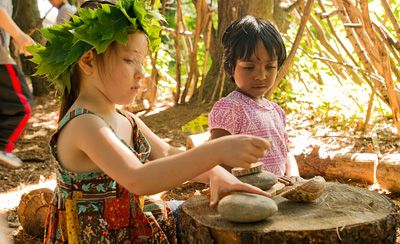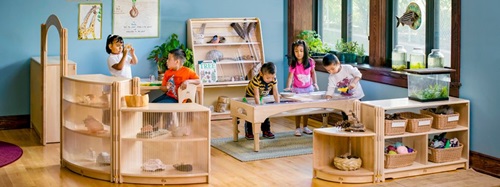Seeing Children do More with Less
| May 2018Imagine not offering babies any toys until they find their hands for play. My mind started spinning as I heard Janet Gonzalez-Mena describe this approach used by the Pikler Institute in Budapest, Hungary, where they have documented over 75 ways that babies learn to use their hands for play.
This is such a different emphasis than what I often see in early childhood programs and homes in the United States. Babies are regularly surrounded by colors and images on walls and fabrics, along with toys that beep, rattle, and flash. Older children are presented with a multitude of toys and materials, together with activities planned and led by teachers and parents. I share some of this emphasis, as one of my favorite things to do is to design and create environments for children. I love to find and offer interesting materials for children’s exploration and learning. I have a wonderful collection of open-ended materials that I present as Invitations, and I always look forward to what children do with what I offer. Although I am always thoughtful to avoid over-stimulation, as well as to ensure the materials encourage children to be the inventors of their work, the story of the Pikler babies and their hands challenged me to rethink my practice. What might be the impact of these different approaches on the development of children’s creativity, initiative, and self-regulation? In my desire to give children all they need to grow and learn, am I giving them too much?
Look to Children to Learn
I always turn to children to be my teachers when I come up against new ideas and challenges. And, indeed, observing closely and reflecting on how children engage in exploration and discovery reinforced the notion that children, in fact, do more with less as the following stories illustrate.
Boxes and Babies
Fourteen-month-old Rosa is sitting on the carpet surrounded by a multitude of interesting boxes that I’ve offered this group of babies in the child care center I’m visiting. She knows better than me, as she scoots herself away from the big pile and finds one box with an attached lid to explore. I watch her work for 20 minutes on the many strategies she can find to open and close the box. She struggles with her motor control, but that doesn’t stop her. I wonder why she isn’t frustrated, as she never quite gets the lid all the way open. She lifts and watches as the lid falls back in place. She listens to the sound it makes as it closes. She holds onto the lid and shakes the box. I barge in and show her how to open it all the way. She wisely ignores me and goes back to her work, partially lifting, watching, shaking, and listening again. I get bored with her exploration of this box, so I get another one and offer it to her. She ignores me again and goes back to her work. I think, “Okay, what’s so interesting about this box?” I lean in to get closer to her experience and that’s when I notice what she has already discovered: there is a slight gust of wind that hits our faces as the lid falls to close!
More with Boxes
My long-time friend and co-worker Rhonda is visiting me with her five-year-old son Finn. I always make sure I have some interesting materials to offer him when he visits. Today I present him with two beautiful piles of tile and wood pieces. He eagerly plays with these for about 10 minutes, until he notices the large, flat cardboard box in my hallway waiting to be recycled. I’m a bit disappointed because I was so excited to give him the beautiful materials. But then I observe him for the next hour as he is immersed in play with this box. He plays on top of the box. It’s a surfboard and a bridge. He stands it up on one side and it becomes a barrier to storm through. He finds different ways to open the box and keep it open, which is no easy task because he has no tape. He invents a game of popping out and going back in the box and plays with this idea over and over again. He gets inside and we hear his dramatic conversations with the imaginary characters that are visiting him in there. At one point he asks for some markers; and then the box becomes his pallet for drawing, writing his name, and then a backdrop for another elaborate drama that unfolds as he draws.
The Flexible Brain
Researcher Alison Gopnik in her book The Philosophical Baby describes the amazing flexibility of young children’s brains. She says humans are born with an undeveloped prefrontal cortex, which is the part of the brain that helps us block out stimulus so we can focus on a task. We often characterize children’s shifting focus as a lack of attention span, when in fact, what is really happening is they have attention for everything. Because children haven’t yet developed the ability to block out stimulus, they actually have the capacity to hear more, see more, and experience more than adults do.
You can certainly see this at work in Rosa’s investigation of the box. My limited focus was on the task of opening the lid. Rosa’s interest was in the many possibilities that the box offered for her exploration, including the breeze she discovered she could create with her actions. My narrow ability to see the many possibilities in that one box as Rosa did, prompted me to interrupt her ingenious explorations. Luckily, at this point in her young life, she has the disposition to stay with her interests, and use her amazing brain the way it was intended. How long will Rosa and other children we work with continue to pursue their innate interests and abilities if adults like me interrupt their explorations with suggestions and offerings of more and more things to distract them?
Self-Regulation and Initiative
Current research in our professional literature, and many recent reports and articles in the news suggest that Finn has developed initiative and self-regulation. According to Hyson, some of the characteristics of children with these skills are:
- Shows curiosity, eagerness, and motivation to learn.
- Identifies and clearly communicates what he wants.
- Delays gratification and has tolerance for frustration.
- Persists at a task with an ability to focus and sustain his attention.
- Reasons, plans, and uses flexible methods for problem solving.
Studies show that children who build initiative and self-regulation skills have more success in school and life. In fact, some say that self-regulation is as important to success as a child’s economic background. This research causes me to squint my eyes and think about my practice: What do I do that may impact children’s opportunity to develop these skills?
- Do I offer too many materials?
- Do I jump in too quickly?
- Do I plan too many things for children to do, leaving them with little time to develop their internal resources?
I think we sometimes have the idea that self-regulation comes from getting children to follow the rules and routines, and to sit still and listen. We spend a lot of time on behavior and group management skills where we use rewards such as stickers or special privileges or punishments like time-out. We plan almost all of the activities and offer materials invented by others on behalf of helping children focus and learn. Yet these are all examples of externally driven strategies that may distract and deter children from their natural eagerness to learn and motivation to be competent, contributing members of our group.
Supporting children in developing self-regulation isn’t an easy task in our complex world and work. I continually remind myself of the importance of slowing down to really see children as I discovered in the following story.
Block Dance
A number of years ago I was confronted with my restricted point of view when I was consulting in a program that had very limited resources and few materials for children to play with. The program I worked for had funding to help the teachers assess their environment and order more materials to enrich the children’s experience. Before the addition of the new materials, I had the pleasure of observing these children do so very much with so little.
The children had access to an open, carpeted area with a small collection of cardboard blocks. One afternoon, as the children woke up from their naps, one by one they slowly took the blocks off the shelf and began to play, until there were nine children negotiating this very small space and small collection of blocks. One of the children built a simple tower adding blocks until it got tippy and fell over. Another child noticed the blocks that had fallen and picked up some of them to use in her tower. She, too, built a structure that eventually fell over. Another child who was working nearby saw the blocks and took some to add to her building. In another corner, a couple of children were connecting five or six blocks together, taking turns, continually rearranging the blocks over and over in harmony and simplicity, but always differently.
I was stunned! There were no outcries when blocks were taken. No complaints about not having enough. No lack of ideas to explore. The children were engaged in a graceful dance of give and take, using this limited supply of blocks in remarkable ways. I witnessed these kinds of gracious interactions among the children during many visits to this program.
At some point the teachers and I worked together to order more materials. When I eagerly arrived to see how things were going with the new things, I discovered the teachers hadn’t put any of the new materials out yet. They were still wrapped in plastic in the cupboards. I suggested we take a variety of things out for the children to explore. I was shocked when offering these new materials provoked very different behavior in the children. This time, even though there were plenty of materials, rather than their usual collaborative play, there was conflict. Children vied for their turns and took things from each other. There were loud complaints and hurt feelings.
As I reflect back on this experience, I wonder if offering children less leads them to invent more cooperative, innovative ways to work together. Does abundance breed greed? Does simplicity grow generosity? This certainly was the case with this group of children.
In our consumer-driven, capitalist society there are many interests competing for what we use in our work with children. Much of what is offered is very seductive. We all want the latest materials, curriculum, or techniques to ensure we give our children all that they deserve. Yet, I want to be cautious and look for inspiration from children. Places such as the Pikler Institute remind us that we as teachers can do so much more with less, just like children do.
Copyright © Exchange Press. Reprinted with permission from Exchange magazine. All rights reserved. Visit us at www.ChildCareExchange.com or call (800) 221-2864.
Read the book!











